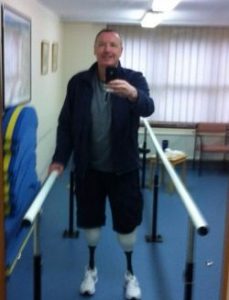David Carson

The UK Sepsis Trust says that ‘feeling like you’re going to die’ could be a sign, among others, that you may have sepsis. Little did I know that on the evening of the 8th of April 2013 that not only would I feel like I was going to die but that a medical team in the intensive care unit of Kettering General Hospital would be doing everything in their power to save me from dying.
I have always tried to keep myself fit and healthy so something like a sore throat and flu like symptoms that I experienced during the first week in April 2013 was, as I have always said, ‘nothing to write home about’. I was still working and didn’t anticipate any time off work. However, on the evening of 8th April 2013 my condition changed and I became very sick. My wife Margaret, who was a nurse, suggested we contact the doctor. I remember talking to the doctor and explaining my symptoms and the doctor suggesting that I take some paracetemol and come to the surgery in the morning. As we had no paracetemol in the house my wife went out to fetch some. When she returned my condition had deteriorated and she wasted no time in calling for an ambulance.
Later I was admitted to Accident and Emergency and after two hours admitted to the Intensive Care Unit with sepsis. My condition kept deteriorating and very soon I was in septic shock and multi organ failure. I was in an induced coma and on a ventilator.
In the early hours of the 9th of April, my wife and one of my sons were taken into a side room and told by the consultant that he had to prepare them for the worst because I had a minimal chance of survival. My son asked the consultant if he could be more specific, like “what’s the percentage chance.” The consultant said he couldn’t. We now know, from discussing this with some of the medical team that no one expected me to live. However my condition did, against all odds, improve thanks to the medical team.
When I was brought out of the induced coma, which I had been in for three weeks, I noticed that I could not lift my hands off the mattress on the bed but I could see my fingers were black. I then noticed my left foot, that was sticking out of the sheet was also black and I could not feel it, neither could I feel my right foot which had also turned black. At that point I felt something like a panic setting in and I tried to say something but found that I could not speak.
Over the next few minutes and hours it was explained to me what had happened and it was because of the tracheostomy that I could not speak. When the tube was removed from my throat my condition was explained to me more fully. It was at this point that I was told my left foot would have to be amputated and that there was a possibility that my right foot would also have to be amputated. I was also told that eventually my fingertips would self amputate (although several months later they had to be amputated in hospital). In my quiet moments at that stage I was in deep despair and now facing the prospect of losing my 2 legs and the tops of my fingers.
Over the next few weeks I had both my legs amputated below the knee and what followed was intense aftercare and physiotherapy to help me walk again. (Sepsis and Amputations) . In addition to coming to terms with what had happened to me it soon became apparent that if I needed rehabilitation that my wife and I would have to fight for it. We were also soon to realise from the Occupational Therapist that our home could not accommodate a wheelchair easily without considerable alterations. As a result we had to find another home that could accommodate the use of a wheelchair. All of this added yet another degree of difficulty to our situation.
Recovering physically and for me learning to walk again was one thing, but there was also the longer term psychological side of things to recover from, this is known as post sepsis syndrome (Sepsis and Post-Sepsis Syndrome) and I’m so glad of the help I received then from a psychologist.
In early 2018 I had a pain in my chest when I was breathing. Right away I was thinking chest infection and sepsis. Margaret called 111 to get advice. When she called she said ‘could it be sepsis’ this important statement is part of the UK Sepsis Trust awareness campaign. As a result an ambulance arrived quickly and took me to hospital. I was diagnosed with pneumonia and sepsis. This time I only spent 4 days in ICU and then I went home.
In August 2022 I had a stem cell transplant due to being diagnosed with Multiple Myeloma blood cancer. During the transplant I developed Neutropenic Sepsis but thankfully the medical team dealt with this quickly.
Life has changed, but life goes on. Margaret and I have now been volunteers for the UK Sepsis Trust since 2014 and we now raise awareness to Sepsis.


























